1979 Ford Mustang, a car that marked a turning point in the iconic pony car’s history, introduced a new generation of Mustang enthusiasts to a more refined and fuel-efficient design. This era saw the introduction of the “Fox Body” platform, a departure from the previous generation, which brought about a more aerodynamic and lighter design, emphasizing practicality without sacrificing the Mustang’s sporty spirit.
The 1979 Mustang faced a challenging automotive landscape, navigating the era of fuel-efficient cars and stricter emissions regulations. Despite these hurdles, it retained its appeal with a range of engine options, each offering a unique blend of power and fuel economy.
Inside, the 1979 Mustang featured a modern interior with updated styling and an array of comfort features, including air conditioning, power steering, and an AM/FM radio, making it a comfortable and enjoyable ride for both daily commutes and weekend adventures.
The 1979 Ford Mustang: A Turning Point in Automotive History
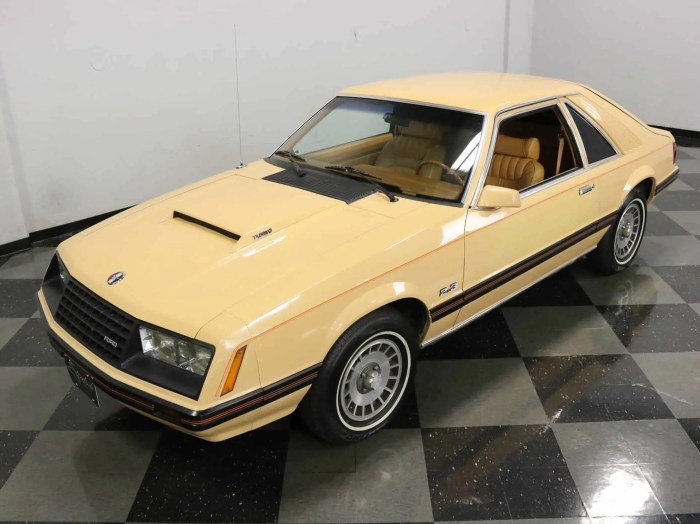
The 1979 Ford Mustang holds a unique position in automotive history. It marked a significant shift in the iconic pony car’s design and engineering, as the industry grappled with the twin challenges of rising fuel prices and stricter emissions regulations.
This model year represents a crucial point in the Mustang’s evolution, paving the way for the future direction of the iconic American sports car.
The Mustang’s Evolution Leading to 1979
The 1979 Mustang was the product of a long and winding road of evolution, shaped by both internal development and external pressures. The first generation Mustang, introduced in 1964, was a roaring success, capturing the hearts of enthusiasts with its sleek design and powerful engines.
However, the 1970s brought about a period of significant change in the automotive landscape. The energy crisis of the early 1970s led to skyrocketing fuel prices, making fuel-efficient cars more desirable. At the same time, increasingly stringent emissions regulations required manufacturers to find new ways to balance performance with environmental responsibility.
- The Second Generation (1974-1978):The second generation Mustang, launched in 1974, represented a significant departure from its predecessors. While it retained the Mustang’s iconic fastback silhouette, it was larger and heavier than previous models. The engine lineup was also scaled back, with the powerful V8s of the past being replaced by smaller, more fuel-efficient engines.
The 1974 Mustang, despite its larger size and less powerful engine options, still retained its popularity and established a new direction for the Mustang.
- The 1979 Model Year:The 1979 Mustang marked a turning point for the model. It received a new front fascia with a more rectangular grille and a more modern appearance. The rear end was also redesigned, featuring rectangular taillights and a more integrated bumper.
The 1979 Ford Mustang, while known for its iconic styling, marked a shift in the muscle car era, focusing more on fuel efficiency. This was a stark contrast to the earlier muscle cars like the 1968 Ford Falcon , which embodied the raw power and performance that defined the 1960s.
The 1979 Mustang, however, continued to capture the hearts of enthusiasts with its sporty design and handling, offering a more refined driving experience.
The 1979 model year also saw the introduction of the “Fox” platform, a new chassis that was lighter and more fuel-efficient than its predecessor. This new platform was crucial in helping the Mustang adapt to the changing automotive landscape.
Design and Styling
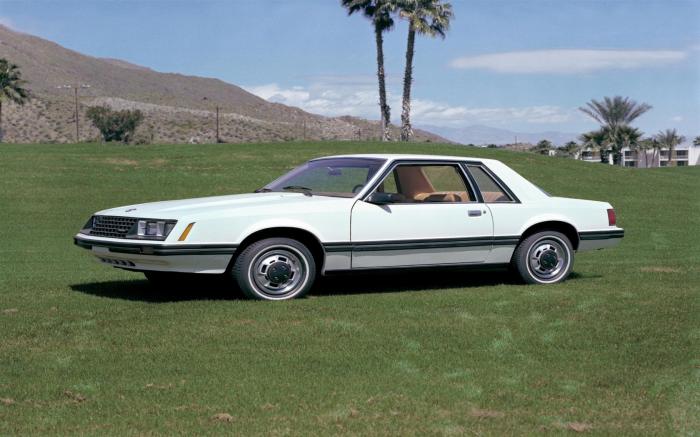
The 1979 Ford Mustang marked a significant departure from its predecessors, ushering in a new era of design and styling that would define the iconic pony car for the next decade. The shift from the second-generation Mustang to the third-generation, known as the “Fox Body,” brought about a host of changes that reflected the changing times and evolving tastes of car buyers.The 1979 Mustang, built on the new Fox Body platform, was a departure from the previous generation’s more rounded and muscular lines.
The Fox Body platform was designed to be lighter and more fuel-efficient, a necessity in the face of rising fuel prices and stricter government regulations. This shift in design philosophy led to a more angular and aerodynamic look for the Mustang.
The Fox Body Platform’s Influence on Mustang Aesthetics
The Fox Body platform had a profound impact on the Mustang’s aesthetics, shaping its overall look and feel. The platform’s inherent design characteristics, such as its shorter wheelbase and wider track, allowed for a more streamlined and athletic profile. This was further accentuated by the use of sharp, angular lines and a more integrated front end.
The result was a Mustang that looked more modern and sporty than its predecessors, while still retaining its classic pony car appeal.
Comparison with Contemporary Styling
The 1979 Mustang’s design was a departure from the prevailing trends in automotive styling at the time. While other muscle cars of the era were still clinging to the more rounded and bulky designs of the 1960s and early 1970s, the Mustang embraced a more angular and aerodynamic look that foreshadowed the design language that would become popular in the 1980s.
The Mustang’s design was also more refined and sophisticated than its competitors, with a more integrated and streamlined appearance.
Distinctive Design Features
The 1979 Mustang featured a number of distinctive design features that set it apart from its predecessors. These included:
- A more angular and aerodynamic front end, with a redesigned grille and headlights.
- A lower, more streamlined profile, thanks to the shorter wheelbase and wider track of the Fox Body platform.
- A more integrated rear end, with a redesigned taillight design and a more sculpted trunk lid.
- A wider range of available wheel and tire combinations, allowing for a more personalized look.
- A new interior design with a more modern and driver-focused layout.
The 1979 Mustang’s distinctive design features contributed to its success, helping to make it one of the most popular and recognizable cars of the late 1970s and early 1980s.
Engine Options and Performance
The 1979 Ford Mustang offered a range of engine options, catering to different performance preferences and budgets. Each engine brought its own unique character to the driving experience, from the fuel-efficient four-cylinder to the powerful V8.
Engine Options and Their Performance Characteristics, 1979 Ford Mustang
The 1979 Mustang provided a choice of three engine options:
- 2.3L Four-Cylinder:This engine, with a modest output of 88 horsepower and 110 lb-ft of torque, was primarily focused on fuel economy. It was not known for its performance, but it offered a practical option for those seeking a more affordable Mustang.
- 4.2L V8:This engine, with 120 horsepower and 195 lb-ft of torque, provided a balance between performance and fuel economy. It was the most popular engine choice, offering a satisfying driving experience for everyday use. It was also the base engine for the Mustang Cobra, which offered improved performance.
The 1979 Ford Mustang, a classic muscle car, was a far cry from the workhorse that the 1988 Ford E350 represented. While the Mustang was designed for speed and style, the E350 was built for hauling and durability. Both vehicles, however, epitomized the American spirit of innovation and engineering, offering distinct experiences for different needs and lifestyles.
- 5.0L V8:This engine, with 140 horsepower and 230 lb-ft of torque, was the top-of-the-line option, offering the most power and performance. It was available on the Mustang Cobra and was a popular choice for enthusiasts seeking a more powerful driving experience.
It was also known for its impressive acceleration and torque, delivering a thrilling ride.
Performance and Driving Experience
The 1979 Mustang, despite its relatively modest power outputs compared to later models, offered a surprisingly enjoyable driving experience. The handling was nimble and responsive, making it fun to drive on winding roads. The suspension was tuned for a comfortable ride, but it could feel a bit soft at times.
The 1979 Mustang’s driving experience was characterized by its agility and responsive handling, offering a fun and engaging drive.
The 2.3L four-cylinder engine, while lacking in power, was surprisingly efficient, offering decent fuel economy for its time. The 4.2L V8 provided a more satisfying driving experience, offering a good balance of performance and fuel economy. The 5.0L V8, while not as powerful as later V8s, offered a thrilling experience, especially for those who enjoyed spirited driving.The 1979 Mustang’s performance was influenced by several factors, including its weight, engine options, and transmission choices.
The car’s weight, while not excessive, did affect its acceleration and handling. The 5.0L V8, with its higher power output, offered the best acceleration and performance, while the 2.3L four-cylinder was the least powerful. The transmission choice also affected the driving experience, with the manual transmission offering more control and a more engaging driving experience than the automatic.The 1979 Mustang was a testament to Ford’s ability to create a fun and engaging driving experience, even with relatively modest power outputs.
It offered a range of engine options to cater to different preferences, providing a satisfying driving experience for both casual drivers and enthusiasts alike.
Interior and Features
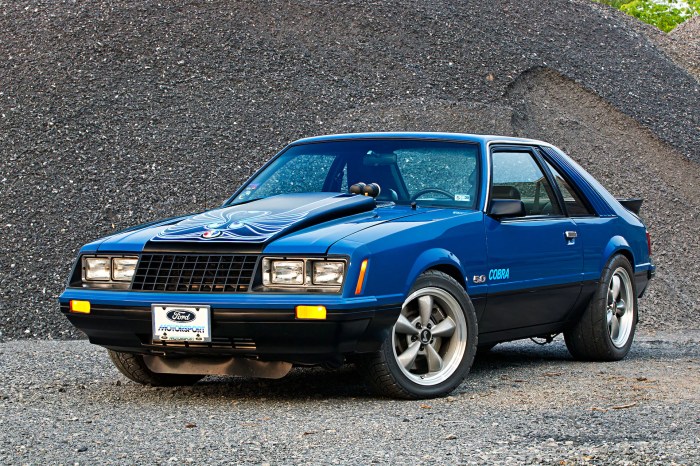
The interior of the 1979 Mustang offered a blend of sporty styling and practical functionality, reflecting the evolving automotive landscape of the late 1970s. While still carrying a sense of its muscle car heritage, the Mustang’s cabin emphasized comfort and convenience, catering to a broader range of drivers.
Interior Design and Layout
The 1979 Mustang’s interior featured a driver-oriented layout with a sporty, yet functional, design. The dashboard was characterized by a clean, horizontal design with large, easy-to-read gauges. The instrument panel housed a speedometer, tachometer, fuel gauge, and temperature gauge, providing essential information at a glance.
The center console was typically equipped with a radio, climate controls, and other essential features. The seats were designed for comfort and support, with vinyl or cloth upholstery depending on the trim level.
Comfort and Convenience Features
The 1979 Mustang offered a range of comfort and convenience features, including:
- Air Conditioning:While not standard, air conditioning was a popular option, offering welcome relief from the summer heat.
- Power Steering:Power steering was available, making the Mustang easier to maneuver, especially in city driving.
- AM/FM Radio:An AM/FM radio was standard equipment, providing entertainment for the driver and passengers.
- Power Windows:Power windows were an option, adding to the convenience of the Mustang’s interior.
- Tilt Steering Wheel:A tilt steering wheel was also available, allowing drivers to adjust the steering wheel position for optimal comfort.
Interior Comparison with Competitors
Compared to its competitors, the 1979 Mustang’s interior offered a decent balance of comfort, features, and affordability. While some competitors offered more luxurious interiors, the Mustang’s interior was generally considered to be well-designed and functional. The Mustang’s interior was also relatively spacious, providing ample room for both driver and passengers.
The 1979 Ford Mustang, despite its somewhat boxy styling, was a popular choice for enthusiasts seeking a sporty and affordable ride. However, if you were looking for something more rugged and capable, the 1979 Ford F150 offered a powerful and dependable alternative.
Both models represented iconic American vehicles from the era, each catering to different driving needs and preferences.
Cultural Impact and Legacy
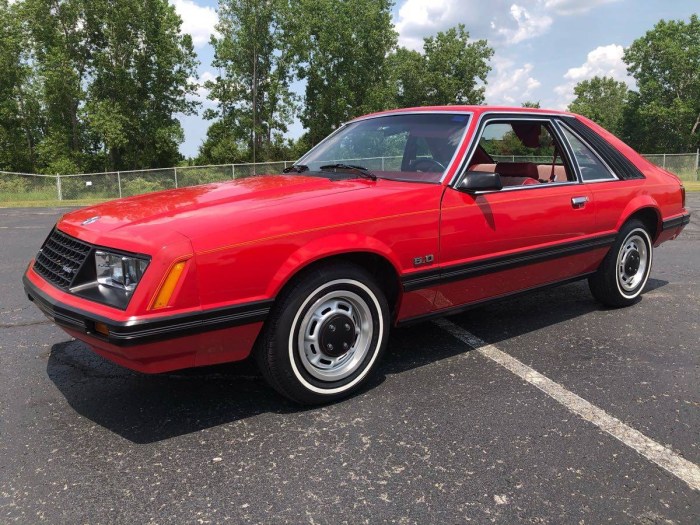
The 1979 Ford Mustang, despite its challenges, left an indelible mark on popular culture and automotive history. It served as a transitional model, bridging the gap between the muscle car era and the fuel-efficient, downsized cars of the 1980s. Its design, while controversial at the time, helped shape the future direction of the Mustang, ultimately contributing to its enduring popularity.
Impact on the Mustang Model Line
The 1979 Mustang marked a turning point for the model line. It introduced a new platform, a more aerodynamic design, and a focus on fuel efficiency. This shift was driven by the energy crisis and changing consumer preferences. While the 1979 Mustang retained some of the classic Mustang elements, its smaller size and more modern styling represented a significant departure from its predecessors.
The 1979 Mustang also introduced new engine options, including the fuel-efficient 2.3-liter four-cylinder engine, which became a staple in the Mustang lineup for years to come. The 1979 Mustang’s focus on fuel economy and modern design set the stage for the Mustang’s evolution throughout the 1980s and beyond.
It paved the way for the iconic Fox-body Mustang, which continued to build on the foundations laid by the 1979 model.
Cultural Significance and Notable Figures
The 1979 Mustang’s cultural impact can be seen in its appearances in popular media, including films and television shows. Its sleek design and sporty appeal made it a popular choice for filmmakers looking to capture a sense of speed and excitement.
The 1979 Mustang also played a role in the rise of the “pony car” culture, which emphasized affordability and performance. The 1979 Mustang also became associated with several notable figures, including:
- The 1979 Mustang Cobra:This special edition model, featuring a black paint scheme and a distinctive Cobra badge, was a highly sought-after collector’s item. It also became a symbol of the Mustang’s performance heritage.
- The 1979 Mustang Pace Car:This special edition model, produced in conjunction with the Indianapolis 500, became a popular collectible and was associated with the excitement of racing.
Collecting and Restoring: 1979 Ford Mustang
The 1979 Ford Mustang, a symbol of American automotive history, has captured the hearts of enthusiasts worldwide. For those seeking to own a piece of this iconic legacy, collecting and restoring a 1979 Mustang can be a rewarding experience. This guide provides insights into the process, common challenges, and resources to help collectors embark on their restoration journey.
Finding a 1979 Mustang
Finding a 1979 Mustang in good condition can be a challenge, as many have been driven for decades and may require extensive restoration. Here are some tips for finding a suitable candidate:
- Online Marketplaces:Websites like Craigslist, eBay, and specialized classic car platforms are excellent starting points for finding 1979 Mustangs for sale. These platforms often offer a wide range of options, from pristine examples to projects in need of significant work.
- Car Shows and Auctions:Attending local car shows and auctions can provide an opportunity to inspect vehicles in person, assess their condition, and connect with fellow enthusiasts.
- Mustang Clubs:Joining a Mustang club can connect you with a network of knowledgeable enthusiasts who may have leads on available vehicles or offer guidance on finding a suitable car.
Assessing Condition and Value
Once you’ve found a potential candidate, it’s crucial to assess its condition and determine its value. This step involves a thorough inspection of the vehicle’s body, interior, engine, and mechanical components.
- Body Condition:Inspect the body for rust, dents, and other damage. Look for signs of previous repairs or accidents, and assess the overall quality of the paint.
- Interior Condition:Evaluate the condition of the upholstery, carpets, dashboard, and other interior components. Look for wear and tear, stains, and any missing or damaged parts.
- Engine and Mechanicals:Listen for unusual noises or vibrations while the engine is running. Check the fluid levels, inspect the belts and hoses, and look for any leaks or signs of wear.
- Documentation:Request any available documentation, such as service records, repair receipts, or the original owner’s manual. These documents can provide valuable insights into the vehicle’s history and maintenance.
Common Restoration Challenges
Restoring a 1979 Mustang can be a labor of love, but it also comes with its share of challenges. Some common issues to anticipate include:
- Rust:Rust is a common problem with older vehicles, especially those that have been exposed to harsh weather conditions. Finding replacement panels or restoring damaged ones can be time-consuming and expensive.
- Parts Availability:While many parts are still available for the 1979 Mustang, some components, especially those that are no longer in production, can be difficult to find. This may require sourcing parts from specialized suppliers or resorting to reproduction parts.
- Engine and Transmission:The 1979 Mustang was equipped with a variety of engines and transmissions, some of which may require specialized knowledge or expertise to rebuild or repair.
- Interior Restoration:Finding original interior parts or replacements in good condition can be challenging. Restoring the interior may require reupholstery, carpet replacement, and other specialized services.
Finding Parts and Accessories
Sourcing parts and accessories for a 1979 Mustang restoration project can be a rewarding journey, but it requires patience and resourcefulness. Here are some options to consider:
- Online Retailers:Numerous online retailers specialize in classic car parts, including those for the 1979 Mustang. These retailers offer a wide selection of new and used parts, as well as restoration supplies.
- Classic Car Parts Suppliers:Specialized classic car parts suppliers often carry a wider selection of parts, including those that are no longer in production. These suppliers may also offer restoration services or advice.
- Mustang Clubs and Forums:Online forums and local Mustang clubs can be valuable resources for finding parts. Members often share information on parts availability, restoration techniques, and suppliers.
- Junkyards:While junkyards may not always have the specific parts you need, they can be a good source for finding used parts in good condition. Be sure to check the condition of any parts you purchase from a junkyard.
Technical Specifications
The 1979 Ford Mustang, despite its design changes, still retained many of the technical specifications of its predecessors. This section delves into the technical specifications of the 1979 Mustang, including its dimensions, weight, suspension, and braking systems.
Technical Specifications of the 1979 Ford Mustang
The following table showcases the technical specifications of the 1979 Ford Mustang:
| Specification | Value |
|---|---|
| Length | 183.3 inches (465.7 cm) |
| Width | 71.1 inches (180.6 cm) |
| Height | 51.5 inches (130.8 cm) |
| Wheelbase | 103.9 inches (264 cm) |
| Curb Weight | 3,000 lbs (1,361 kg) |
| Engine | 4.2 L (255 cu in) V6, 5.0 L (302 cu in) V8, 5.8 L (351 cu in) V8 |
| Transmission | 3-speed automatic, 4-speed manual, 5-speed manual |
| Suspension (Front) | Independent, coil springs, MacPherson struts |
| Suspension (Rear) | Live axle, leaf springs |
| Brakes (Front) | Disc |
| Brakes (Rear) | Drum |
Comparison of Specifications with Predecessors and Successors
The 1979 Ford Mustang represented a turning point in the model’s history. Comparing its specifications with its predecessors and successors highlights its evolution:
| Specification | 1974 Mustang | 1979 Mustang | 1984 Mustang |
|---|---|---|---|
| Length | 184.3 inches | 183.3 inches | 184.6 inches |
| Width | 71.5 inches | 71.1 inches | 71.1 inches |
| Height | 51.1 inches | 51.5 inches | 50.4 inches |
| Wheelbase | 103.9 inches | 103.9 inches | 100.4 inches |
| Curb Weight | 2,950 lbs | 3,000 lbs | 2,950 lbs |
| Engine | 2.3 L (140 cu in) 4-cylinder, 3.3 L (200 cu in) V6, 5.0 L (302 cu in) V8 | 4.2 L (255 cu in) V6, 5.0 L (302 cu in) V8, 5.8 L (351 cu in) V8 | 2.3 L (140 cu in) 4-cylinder, 3.8 L (232 cu in) V6, 5.0 L (302 cu in) V8 |
| Transmission | 3-speed automatic, 4-speed manual | 3-speed automatic, 4-speed manual, 5-speed manual | 3-speed automatic, 4-speed manual, 5-speed manual |
This comparison reveals that the 1979 Mustang maintained a similar size and weight to its predecessors but introduced a new V6 engine option. It also featured a revised suspension and braking system, further enhancing its driving dynamics.
Illustrative Examples
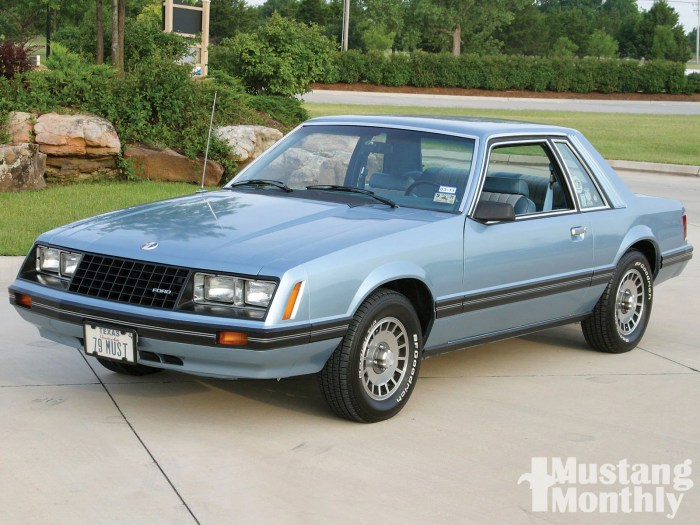
The 1979 Mustang offered a diverse range of models, each catering to different tastes and needs. This section explores some of the most notable examples, showcasing their unique features, options, and historical significance.
Notable 1979 Mustang Models
The 1979 Mustang lineup was diverse, offering various options to appeal to different drivers. Here are some of the most notable models:
- 1979 Ford Mustang Cobra: The Cobra, available in both coupe and hatchback body styles, was the performance-oriented model. It featured a 5.0L V8 engine with a 4-barrel carburetor, generating 140 horsepower. The Cobra came with a unique hood scoop, special badging, and a sport suspension for enhanced handling.
The Cobra was a popular choice for enthusiasts seeking a sporty and affordable Mustang.
- 1979 Ford Mustang Ghia: The Ghia, a limited-edition model, offered a luxurious interior with upgraded materials and features. It featured plush velour upholstery, woodgrain accents, and a distinctive grille. The Ghia was targeted towards buyers seeking a more refined and sophisticated Mustang experience.
- 1979 Ford Mustang King Cobra: While not officially produced by Ford, the King Cobra was a popular aftermarket modification. It involved adding a more powerful engine, such as a 351 Cleveland V8 or a 429 Super Cobra Jet, along with other performance enhancements. These modifications transformed the Mustang into a formidable street machine, attracting drag racing enthusiasts and those seeking maximum power.
Visual Representation of a 1979 Mustang
Imagine a 1979 Ford Mustang, a classic example of the era’s automotive design. Its exterior features sharp lines, a long hood, and a sloping roofline. The iconic Mustang grille, with its vertical chrome bars, dominates the front fascia. The rear end boasts distinctive taillights and a chrome bumper.
The car is painted in a vibrant shade of red, highlighting its sporty character.Inside, the cabin is a blend of functionality and style. The dashboard is a mix of black vinyl and chrome accents, featuring a classic instrument cluster and a three-spoke steering wheel.
The seats are comfortable and supportive, upholstered in a durable fabric. The overall interior design exudes a sense of classic American muscle car charm.
Historical Photographs and Videos
Historical photographs and videos provide a glimpse into the 1979 Mustang’s use in various contexts. Images showcase the Mustang on the streets of American cities, cruising down highways, and even participating in drag races. These visuals highlight the car’s popularity as a daily driver, a weekend cruiser, and a performance machine.Videos from the era offer a dynamic perspective, capturing the Mustang’s acceleration, handling, and overall driving experience.
They showcase the car’s unique sound, its distinctive styling, and its appeal to a wide range of drivers.
Conclusion
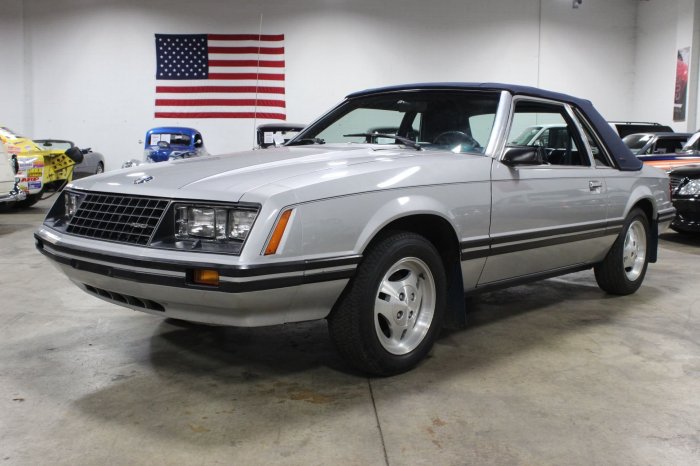
The 1979 Ford Mustang, while a departure from its predecessors, still managed to capture the hearts of enthusiasts. Its blend of classic Mustang styling with modern practicality and fuel efficiency ensured its place in automotive history. Today, the 1979 Mustang remains a popular choice for collectors and enthusiasts, offering a glimpse into a pivotal era in the pony car’s evolution.
Whether you’re drawn to its sleek design, powerful engine options, or its place in pop culture, the 1979 Mustang continues to hold a special place in the hearts of car enthusiasts worldwide.